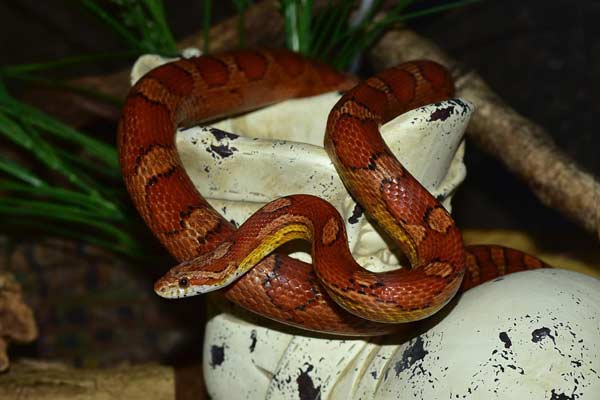What goes in must come out, and that old rule also applies to snakes. You might not have thought much about the toilet habits of species like the corn snake, but they can say a lot about your pet’s health.
How often should a corn snake poop, and what does it mean if your snake seems a little constipated?
Generally, corn snakes are very efficient with their bowel movements. They only poop after fully digesting a meal, and they only eat once every week or two. If your snake is otherwise healthy, you can expect to see two to four poops a month.
How do Snakes Digest Their Food?
Snakes are opportunistic predators. They evolved to go without food for long periods and then eat large amounts. Because of their unique lifestyle, they also possess highly efficient digestive tracts. Every bit of helpful nutrition is absorbed before expulsion.
Snakes famously swallow their prey whole. The unfortunate mouse or other animal slides down the snake’s esophagus and into its stomach. What happens after that?
Powerful muscles down the snake’s body act like teeth, “chewing” the food as it moves. Then, strong acids slowly break the animal down in the stomach, and its nutrients are released.
Digesting on a Snake’s Schedule
Unlike human beings, a snake’s system is in no rush to get rid of its last meal. Corn snakes typically pass food a few days after eating it, when it’s been entirely digested. They also only poop once per meal, meaning some of their leavings can be pretty significant.
How Often Should a Pet Corn Snake Poop?
Many new snake owners see their pet’s rare poops and worry something’s gone wrong. In most cases, the snake is fine and simply taking its sweet time digesting.
As a rule of thumb, it’s probably healthy so long as your snake poops at least twice a month. However, constipation or blockages do occur and can be fatal.
As a pet owner, you must notice when your corn snake may be in digestive trouble. But how can you be sure?
Following Your Snake’s Schedule
Feeding snakes isn’t an exact science, but offering your snake food consistently is a good idea. Following a regular feeding schedule makes it easier to notice when something’s off.
Young corn snakes need to eat about once per week. Adults may go as long as two weeks without eating comfortably.
What Does it Mean When Your Corn Snake Isn’t Pooping?
If you clean your corn snake’s cage regularly, you should notice when your snake isn’t leaving its usual “gifts.” Before panicking, wait a few extra days in case it just needs some spare time.
But if your corn snake goes for several feeding cycles without pooping or stops eating and drinking, you could be dealing with a medical issue.
Signs of a constipated snake include sluggishness, bloating, and a lack of appetite. You might notice a bulging section just ahead of its cloaca. Don’t, however, try to squeeze this blockage out. As the condition progresses, you’ll see dull scales and eyes, which may regurgitate subsequent meals.
Monitoring Your Pet’s Poop
Besides frequency, other aspects of your snake’s bowel movements can tell you a lot about its overall health.
A regular snake poop tends to be dark brown or black, sometimes accompanied by a little mucus or urine. You might also find undigested bits of its last meal.
Strange colors or a runny consistency point to possible health issues. Bright red stools are particularly concerned, as they can indicate bleeding in the snake’s digestive tract. Whenever you see red in a snake’s feces, contact your veterinarian right away.
Helping a Constipated Snake
So what can you do if your pet snake isn’t pooping? These four steps may help your snake pass a blockage:
- Keeping the snake hydrated
- Checking its cage temperature
- Stimulating bowel movements
- Adjusting feeding habits
Most cases of a constipated snake stem from dehydration. When your corn snake isn’t getting enough water, its system can’t digest and move waste efficiently.
Make sure your snake always has access to fresh, clean water. It can be challenging to observe your snake drinking, so monitor fluid levels as you change its water instead.
Turning the temperature can also encourage your snake to go to the bathroom. Double-check that its enclosure falls within recommended temperature ranges, and turn heat lamps toward the high side if needed.
Because snakes are cold-blooded, heat encourages their system to kick into gear. This might be all your corn snake needs to pass its food.
You can also take measures to assist a constipated snake actively. Corn snakes don’t mind and even enjoy spending time in the water.
Fill a shallow dish, so your pet is submerged without needing to swim. Then place it in the water and allow it to remain there for about 15 minutes. Do this every day until it relieves itself.
If your corn snake is prone to constipation, consider adjusting its feeding regimen. Instead of one large meal, such as a rat, give it several smaller meals, like mice. This can prevent too much buildup, which leads to blockages.
Seeking Veterinary Help
When nothing else works, it may be time to bring the corn snake to a veterinarian. Your vet will be able to examine the snake, take images of its insides, and suggest the best course of action to fix the situation. When in doubt, seek professional veterinary help before it’s too late.
Despite their sometimes gross nature, being aware of droppings is essential to snake ownership.
By understanding how your corn snake’s digestive system works and what signs to look for, you can offer it the best quality of life possible.
